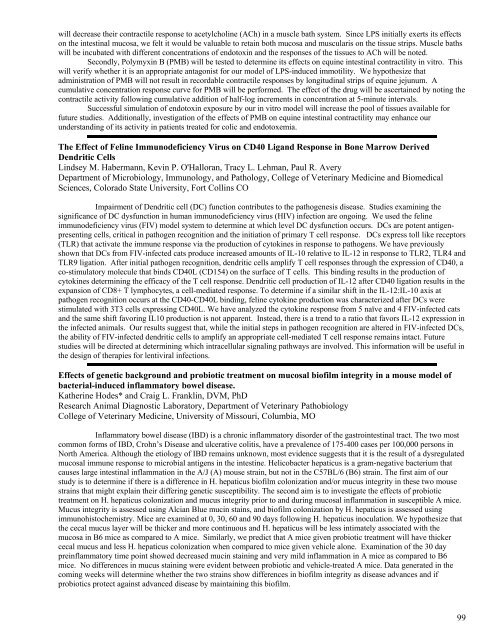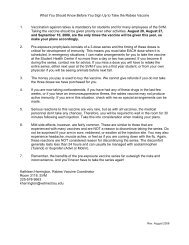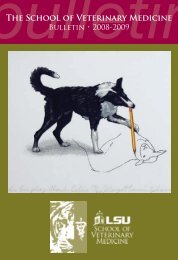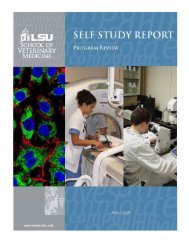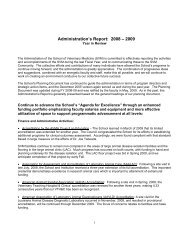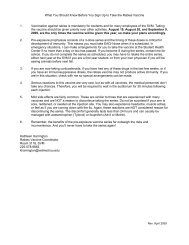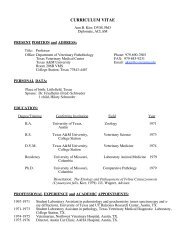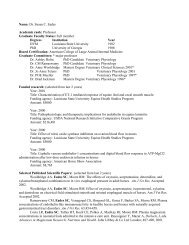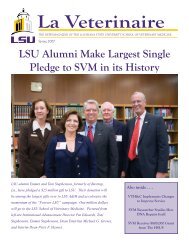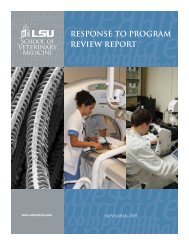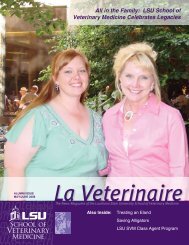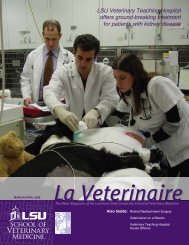has been isolated from all samples and standardized. Results from duplex quantitative PCR assay comparing MDV gB and aunique host chicken sequence are pending. Supported in part by the Witter Fellowship at MSU and NIHT-35RR017491.Inducing Transmissible Spongiform Encephalopathies in White-tailed Deer using Spiroplasma mirum.Hilari French 2 *, Sue Hagius 1 , Joel Walker 1 , Fred Enright 1 , Frank Bastian 1 , and Philip Elzer 1,2Department <strong>of</strong> <strong>Veterinary</strong> Science 1 , <strong>Louisiana</strong> <strong>State</strong> University Agricultural Center<strong>School</strong> <strong>of</strong> <strong>Veterinary</strong> <strong>Medicine</strong>, <strong>Louisiana</strong> <strong>State</strong> University 2Current research on transmissible spongiform encephalopathies (TSE) has centered on the origin <strong>of</strong> the abnormalprion that causes the characteristic neurological defects in many different animal species. Research has revealed that anabnormal prion does not have to be present at all for TSE pathology to occur, and there is discussion that inoculation <strong>of</strong>abnormal prions alone will not induce TSE infections. One bacterium, Spiroplasma mirum, has been found to be associatedwith TSE infections in various animal species. We hypothesize that neonatal white-tailed deer injected with S. mirum willdevelop the characteristic signs <strong>of</strong> chronic wasting disease (CWD), the cervid form <strong>of</strong> TSE. Neonates will be inoculated withpure cultures <strong>of</strong> S. mirum via intracranial injection into the right hemisphere between the fontanels using a 23-gauge needle.Animals will be euthanatized upon onset <strong>of</strong> clinical signs or at the termination <strong>of</strong> the study if no symptoms develop. Controlanimals inoculated with media alone will be sacrificed concurrently with the experimental animals.Three out <strong>of</strong> four deer inoculated intracranially with S. mirum in a previous study developed clinical signs, and allfour exhibited histological changes consistent with spongiform encephalopathies (vacuolar encephalopathy with prominentperineuronal vacuoles). Microglia proliferation was observed throughout the brain, but there was no evidence <strong>of</strong> anysignificant inflammation. The spongiform changes were most prevalent in the cerebellar tissue and brain stem which is wherethey are located in the naturally-occurring disease. Neonatal white-tailed deer appear to serve as a model for CWD in thatexperimental infection with S. mirum leads to the induction <strong>of</strong> clinical symptoms and histological findings <strong>of</strong> spongiformchange in the brain.Role <strong>of</strong> c-KIT in Gastrointestinal Stromal TumorsEmmalena Gregory-Bryson*, Elizabeth Bartlett, Schantel Hayes, Matti Kiupel, and Vilma Yuzbasiyan-GurkanCollege <strong>of</strong> <strong>Veterinary</strong> <strong>Medicine</strong>, Michigan <strong>State</strong> University, East Lansing, MI 48824Gastrointestinal stromal tumors (GIST) are the most common mesenchymal neoplasms in the GI tract <strong>of</strong> humansand have also been described in dogs. GISTs are a separate neoplastic entity from smooth muscle and neural tumors that arethought to originate from the interstitial cells <strong>of</strong> Cajal and typically express KIT (CD117), a tyrosine kinase receptor encodedby the proto-oncogene c-KIT. Little is known about the pathogenesis <strong>of</strong> these malignant neoplasms. The purpose <strong>of</strong> this studyis to evaluate the role <strong>of</strong> c-KIT in GISTs, specifically, investigating gain <strong>of</strong> function mutations in exon 11 <strong>of</strong> c-KIT, whichhave been implicated in many tumors, including canine mast cell tumors (MCT). Formalin-fixed, paraffin-embedded tissues<strong>of</strong> 17 canine GISTs with confirmed positive KIT immunostaining were included in this study. Of these dogs, 71% werefemale and 29% were male and represented various dog breeds. These dogs ranged from 4 to 15 years old. Exon 11, codingfor the juxtamembrane domain <strong>of</strong> KIT, was amplified from neoplastic tissue. 14 <strong>of</strong> these cases yielded amplificationproducts, with 6 showing an aberrant banding pattern. Sequencing <strong>of</strong> 3 <strong>of</strong> the aberrant patterns identified in frame deletions.The analysis <strong>of</strong> the other aberrant bands is ongoing. The mutations include two different, but overlapping 6 base pairdeletions, which translate to a deletion <strong>of</strong> 2 amino acids in one case and an amino acid change and a deletion <strong>of</strong> 2 amino acidsin the other case. Interestingly, these deletion mutations are the same as those previously found in the juxtamembrane domain<strong>of</strong> c-KIT in MCTs in our laboratory. The expression <strong>of</strong> KIT and the presence <strong>of</strong> these mutations in c-KIT implicate KIT inthe pathogenesis <strong>of</strong> these tumors. While preliminary, our results indicate that mutations in KIT may be <strong>of</strong> prognosticsignificance and that targeting KIT may be a rational approach to treatment <strong>of</strong> these malignant neoplasms. Supported in partby grant number NIHT-35RR017491 to Michigan <strong>State</strong> University.Evaluation <strong>of</strong> the effects <strong>of</strong> endotoxin and Polymyxin B on longitudinal smooth muscle <strong>of</strong> equine jejunumin vitroShannon Guy*, Micah Bishop, Dehong Li, Erin Malone, and Robert WashabauGastrointestinal Physiology Laboratory, College <strong>of</strong> <strong>Veterinary</strong> <strong>Medicine</strong>, University <strong>of</strong> MinnesotaUp to forty percent <strong>of</strong> horses admitted to veterinary teaching hospitals for colic are in a state <strong>of</strong> endotoxicshock. The inflammatory cascade initiated by lipopolysaccharide (LPS) destroys the epithelial barrier in the gut, exposing therest <strong>of</strong> the body to the effects <strong>of</strong> endotoxemia. Within the GI tract, LPS induces production <strong>of</strong> inflammatory immunemediators that inhibit motility, thereby producing ileus. Indeed, in the presence <strong>of</strong> LPS, phenylephrine has been shown toelicit weaker than normal contractions in intestinal smooth muscle. Because <strong>of</strong> its ability to bind the Lipid A portion <strong>of</strong> theLPS molecule, treatment with Polymyxin B is an <strong>of</strong>ten an adjunct therapy for endotoxemia.This study is a pilot project whose objective is tw<strong>of</strong>old. The first objective is to establish an in vitro model <strong>of</strong> LPSinducedileus. Our hypothesis is that in vitro administration <strong>of</strong> endotoxin (E. coli O55:B5) on jejunal smooth muscle strips98
will decrease their contractile response to acetylcholine (ACh) in a muscle bath system. Since LPS initially exerts its effectson the intestinal mucosa, we felt it would be valuable to retain both mucosa and muscularis on the tissue strips. Muscle bathswill be incubated with different concentrations <strong>of</strong> endotoxin and the responses <strong>of</strong> the tissues to ACh will be noted.Secondly, Polymyxin B (PMB) will be tested to determine its effects on equine intestinal contractility in vitro. Thiswill verify whether it is an appropriate antagonist for our model <strong>of</strong> LPS-induced immotility. We hypothesize thatadministration <strong>of</strong> PMB will not result in recordable contractile responses by longitudinal strips <strong>of</strong> equine jejunum. Acumulative concentration response curve for PMB will be performed. The effect <strong>of</strong> the drug will be ascertained by noting thecontractile activity following cumulative addition <strong>of</strong> half-log increments in concentration at 5-minute intervals.Successful simulation <strong>of</strong> endotoxin exposure by our in vitro model will increase the pool <strong>of</strong> tissues available forfuture studies. Additionally, investigation <strong>of</strong> the effects <strong>of</strong> PMB on equine intestinal contractility may enhance ourunderstanding <strong>of</strong> its activity in patients treated for colic and endotoxemia.The Effect <strong>of</strong> Feline Immunodeficiency Virus on CD40 Ligand Response in Bone Marrow DerivedDendritic CellsLindsey M. Habermann, Kevin P. O'Halloran, Tracy L. Lehman, Paul R. AveryDepartment <strong>of</strong> Microbiology, Immunology, and Pathology, College <strong>of</strong> <strong>Veterinary</strong> <strong>Medicine</strong> and BiomedicalSciences, Colorado <strong>State</strong> University, Fort Collins COImpairment <strong>of</strong> Dendritic cell (DC) function contributes to the pathogenesis disease. Studies examining thesignificance <strong>of</strong> DC dysfunction in human immunodeficiency virus (HIV) infection are ongoing. We used the felineimmunodeficiency virus (FIV) model system to determine at which level DC dysfunction occurs. DCs are potent antigenpresentingcells, critical in pathogen recognition and the initiation <strong>of</strong> primary T cell response. DCs express toll like receptors(TLR) that activate the immune response via the production <strong>of</strong> cytokines in response to pathogens. We have previouslyshown that DCs from FIV-infected cats produce increased amounts <strong>of</strong> IL-10 relative to IL-12 in response to TLR2, TLR4 andTLR9 ligation. After initial pathogen recognition, dendritic cells amplify T cell responses through the expression <strong>of</strong> CD40, aco-stimulatory molecule that binds CD40L (CD154) on the surface <strong>of</strong> T cells. This binding results in the production <strong>of</strong>cytokines determining the efficacy <strong>of</strong> the T cell response. Dendritic cell production <strong>of</strong> IL-12 after CD40 ligation results in theexpansion <strong>of</strong> CD8+ T lymphocytes, a cell-mediated response. To determine if a similar shift in the IL-12:IL-10 axis atpathogen recognition occurs at the CD40-CD40L binding, feline cytokine production was characterized after DCs werestimulated with 3T3 cells expressing CD40L. We have analyzed the cytokine response from 5 naïve and 4 FIV-infected catsand the same shift favoring IL10 production is not apparent. Instead, there is a trend to a ratio that favors IL-12 expression inthe infected animals. Our results suggest that, while the initial steps in pathogen recognition are altered in FIV-infected DCs,the ability <strong>of</strong> FIV-infected dendritic cells to amplify an appropriate cell-mediated T cell response remains intact. Futurestudies will be directed at determining which intracellular signaling pathways are involved. This information will be useful inthe design <strong>of</strong> therapies for lentiviral infections.Effects <strong>of</strong> genetic background and probiotic treatment on mucosal bi<strong>of</strong>ilm integrity in a mouse model <strong>of</strong>bacterial-induced inflammatory bowel disease.Katherine Hodes* and Craig L. Franklin, DVM, PhDResearch Animal Diagnostic Laboratory, Department <strong>of</strong> <strong>Veterinary</strong> PathobiologyCollege <strong>of</strong> <strong>Veterinary</strong> <strong>Medicine</strong>, University <strong>of</strong> Missouri, Columbia, MOInflammatory bowel disease (IBD) is a chronic inflammatory disorder <strong>of</strong> the gastrointestinal tract. The two mostcommon forms <strong>of</strong> IBD, Crohn’s Disease and ulcerative colitis, have a prevalence <strong>of</strong> 175-400 cases per 100,000 persons inNorth America. Although the etiology <strong>of</strong> IBD remains unknown, most evidence suggests that it is the result <strong>of</strong> a dysregulatedmucosal immune response to microbial antigens in the intestine. Helicobacter hepaticus is a gram-negative bacterium thatcauses large intestinal inflammation in the A/J (A) mouse strain, but not in the C57BL/6 (B6) strain. The first aim <strong>of</strong> ourstudy is to determine if there is a difference in H. hepaticus bi<strong>of</strong>ilm colonization and/or mucus integrity in these two mousestrains that might explain their differing genetic susceptibility. The second aim is to investigate the effects <strong>of</strong> probiotictreatment on H. hepaticus colonization and mucus integrity prior to and during mucosal inflammation in susceptible A mice.Mucus integrity is assessed using Alcian Blue mucin stains, and bi<strong>of</strong>ilm colonization by H. hepaticus is assessed usingimmunohistochemistry. Mice are examined at 0, 30, 60 and 90 days following H. hepaticus inoculation. We hypothesize thatthe cecal mucus layer will be thicker and more continuous and H. hepaticus will be less intimately associated with themucosa in B6 mice as compared to A mice. Similarly, we predict that A mice given probiotic treatment will have thickercecal mucus and less H. hepaticus colonization when compared to mice given vehicle alone. Examination <strong>of</strong> the 30 daypreinflammatory time point showed decreased mucin staining and very mild inflammation in A mice as compared to B6mice. No differences in mucus staining were evident between probiotic and vehicle-treated A mice. Data generated in thecoming weeks will determine whether the two strains show differences in bi<strong>of</strong>ilm integrity as disease advances and ifprobiotics protect against advanced disease by maintaining this bi<strong>of</strong>ilm.99
- Page 1 and 2:
2006 MERCK/MERIALNATIONAL VETERINAR
- Page 6 and 7:
3:00-3:30 pm BreakNovel therapy for
- Page 8 and 9:
KEYNOTE SPEAKERRonald Veazey, D.V.M
- Page 10 and 11:
Mini Symposium II:Fish Research: A
- Page 12 and 13:
David G. Baker, D.V.M., M.S., Ph.D.
- Page 14 and 15:
Konstantin G. Kousoulas, Ph.D.Profe
- Page 16 and 17:
Joseph Francis, B.V.Sc., M.V.Sc., P
- Page 18 and 19:
dogs with cancer, the potential rol
- Page 20 and 21:
2006 MERCK/MERIALVETERINARY SCHOLAR
- Page 22 and 23:
YOUNG INVESTIGATOR AWARD HONORABLE
- Page 24 and 25:
Mammary epithelial-specific deletio
- Page 26 and 27:
2006 MERCK/MERIALVETERINARY SCHOLAR
- Page 28:
Variation in Q-Tract Length of the
- Page 34:
Novel therapy for humoral hypercalc
- Page 38:
ALTERNATE:Micron-scale membrane sub
- Page 42 and 43:
ABSTRACT TITLES LISTED BY CATEGORY
- Page 44 and 45:
19. A pilot study of cigarette smok
- Page 46 and 47:
36. Development of a murine in vitr
- Page 48 and 49: ABSTRACT TITLES LISTED BY CATEGORY
- Page 50 and 51: 71. Identification and characteriza
- Page 52 and 53: 85. Age and Gender Influence Ventil
- Page 54 and 55: ABSTRACT TITLES LISTED BY CATEGORY
- Page 56 and 57: 2006 MERCK/MERIALVETERINARY SCHOLAR
- Page 58 and 59: 10. Preliminary estimation of risk
- Page 60 and 61: ABSTRACT TITLES LISTED BY CATEGORY
- Page 62 and 63: 47. Osteoprotegerin and Receptor Ac
- Page 64 and 65: 61. A Comparison of Interaction Pat
- Page 66 and 67: ABSTRACT TITLES LISTED BY CATEGORY
- Page 68 and 69: ABSTRACT TITLES LISTED BY CATEGORY
- Page 70 and 71: ABSTRACT TITLES LISTED BY CATEGORY
- Page 72 and 73: 2006 MERCK/MERIALVETERINARY SCHOLAR
- Page 74 and 75: used to label avian heterophils for
- Page 76 and 77: obtained via analysis of time and d
- Page 78 and 79: 0.71mg/dL; p=0.001). Values for hem
- Page 80 and 81: mass and fecundity in prespawning w
- Page 82 and 83: Equine Hoof Laminae Tissue Collecti
- Page 84 and 85: Aspiration Pneumonia in DogsDavid A
- Page 86 and 87: Distortion Product Otoacoustic Emis
- Page 88 and 89: tyrosine phosphorylation is measure
- Page 90 and 91: the gravid and non-gravid females t
- Page 92 and 93: egulatory function as its ortholog,
- Page 94 and 95: PATHOLOGY, TOXICOLOGY, AND ONCOLOGY
- Page 96 and 97: Markers of Oxidative Stress in plas
- Page 100 and 101: Matrix metalloproteinase secretion
- Page 102 and 103: Reproductive performance, neonatal
- Page 104 and 105: control to determine the efficiency
- Page 106 and 107: Enhancing the Quality and Reliabili
- Page 108 and 109: grade II MCTs into groups with good
- Page 110 and 111: Transcriptional Regulation of the I
- Page 112 and 113: MICROBIOLOGY AND IMMUNOLOGY (SESSIO
- Page 114 and 115: colonization of the mutant and 6 re
- Page 116 and 117: digestive tracts of these and other
- Page 118 and 119: 100 pfu BRSV. The results show that
- Page 120 and 121: Inhibition of Microneme Secretion i
- Page 122 and 123: Adherent bacilli were present in th
- Page 124 and 125: isolated to analyze cytokine gene e
- Page 126 and 127: purified, viral RNA was extracted a
- Page 128 and 129: The effects of co-engagement of TLR
- Page 130 and 131: Occurrence of Leptospira Vaccine Fa
- Page 132 and 133: undifferentiated catecholaminergic
- Page 134 and 135: the concept that the greater detoxi
- Page 136 and 137: quantitative PCR using gene targets
- Page 138 and 139: Rotenone Induced Dopamine Neuron De
- Page 140 and 141: decrease in serum cortisol, with a
- Page 142 and 143: and detrimental impacts on the brai
- Page 144 and 145: actions of cells prior to embryo de
- Page 146 and 147: Utilizing cDNA Subtraction to Exami
- Page 148 and 149:
expression in unilaterally pregnant
- Page 150 and 151:
Salmonella is increased. Poultry sa
- Page 152 and 153:
exports. The estimated prevalence o
- Page 154 and 155:
eeding grounds near Minnedosa, MB s
- Page 156 and 157:
(PBMC) were isolated using commerci
- Page 158 and 159:
2006 MERCK/MERIALVETERINARY SCHOLAR
- Page 160 and 161:
Trainees acquire in-depth knowledge
- Page 162 and 163:
comparative pathology and/or resear
- Page 164 and 165:
Department of Veterinary Bioscience
- Page 166 and 167:
PhD, Director, Center for Comparati
- Page 168 and 169:
2006 MERCK/MERIALVETERINARY SCHOLAR
- Page 170 and 171:
MICHIGAN STATEUNIVERSITYJames Crawf
- Page 172:
UNIVERSITY OFPENNSYLVANIALindsay Th


